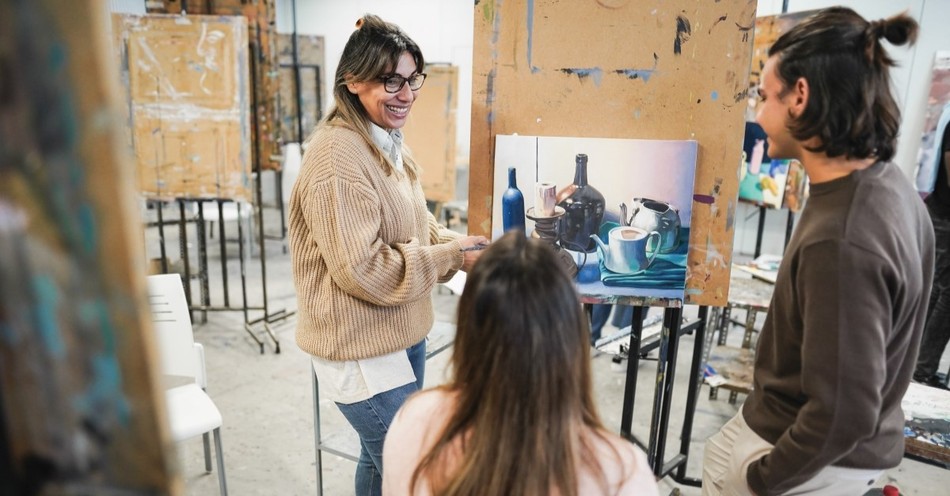To some Christians, talking about art is frivolous. The Bible reflects a different opinion. God doesn’t encourage us to belittle its contribution to the physical world or our spiritual lives.
Artist and author Makoto Fujimura (whose excellent books include Culture Care and Art and Faith) gives this great insight in the foreword of Michael Card’s Scribbling in the Sand:
“Christ entered our world, the Creator translating heavenly existence to earthly. When our faith in Christ is combined with our own human efforts at creation, the act forges a richer and more diverse form of communication. Artists throughout the centuries have sought to tap into the transcendent by their creating. The language of the arts, it can be argued, is a language born of faith.”
What Does the Bible Say about Creating Things?
The Bible’s first sentence shows the significance of creating things as the creation story unfolds. Genesis 1 records how God spent five days dividing the heavens and creating the sky, dry land, stars, sun, moon, fish, and birds. Each day, He looked at His creation and called it good (Genesis 1:4, 1:12, 1:18, 1:21, 1:25). On the sixth day, God created creatures. In Genesis 1:26, the Trinity created humanity in their image and likeness, both male and female. God called it very good when He saw all He made that day (Genesis 1:31). God took time to look at His creation and found delight in its sights, details, colors, scents, and sounds.
David observes in Psalm 19:1 that the heavens declare God’s glory, the skies proclaiming his handiwork. We reveal His glory, as do the heavens and skies and all of God’s creation. Everything was created with purpose but also with pleasure.
Does the Bible Verse about No Graven Images Mean No Art?
Proverbs 16:2 says the LORD weighs our motives. Eve took the fruit because, in her heart, she wanted to be like God and since that first bite, every human has fallen prey to the same lie at some point.
When we consider Isaiah 44:15-17, the motives are clear. In verses 6-7, the LORD Almighty proclaims that He alone is the first and the last; apart from Him, there is no God. “Who then is like me?” Those who create idols or worship false gods are foolish and useless, as is their art, for it is made for the express purpose of worshipping something other than their Creator God. “Such a person feeds on ashes; a deluded heart misleads him; he cannot save himself or say, ‘Is not this thing in my right hand a lie?’” (Isaiah 44:20)
We are created in God’s image (Genesis 1:27); because of this, we too are wired to create and desire a sanctified imagination. N.T. Wright reflects on how we can use art to heal the world and rethink about the future God has in store for us.
“The point is this. The arts are not the pretty but irrelevant bits around the border of reality. They are the highways into the center of a reality which cannot be glimpsed, let alone grasped, any other way. The present world is good but broken and in any case incomplete; art of all kinds enables us to understand that paradox in its many dimensions. But the present world is also designed for something which has not yet happened. It is like a violin waiting to be played: beautiful to look at, graceful to hold—and yet if you’d never heard one in the hands of a musician, you wouldn’t believe the new dimensions of beauty yet to be revealed. Perhaps art can show something of that, can glimpse the future possibilities pregnant within the present time.” ― N.T. Wright, Simply Christian
What Does the Bible Say about Making Art?
The theme of making art is woven throughout the Bible. In Genesis 2:15, God gives Adam the responsibility to tend the Garden. To partner with God in cultivating beauty, whether for food or the simple pleasure a beautiful flower brings, is one of the greatest and most enjoyable privileges we share as believers.
Here are a few short examples of people in the Bible who craft things or make artwork:
1. In Genesis 6:14, Noah built an ark following God’s instructions. It had a clear function (to save people and animals from a flood), but it also had to be well-made. Noah had to craft it, even if it wasn’t “beautiful” in the way we would talk about an oil painting.
2. In Exodus 31, we’re introduced to Bezalel, the chief artisan for the Tabernacle’s construction. The LORD filled him with the Spirit of God, with wisdom, with understanding, with knowledge, and all kinds of artistic skills.
3. In Nehemiah 3:8, we’re told of Uzziel son of the goldsmith Harhaiah, and the perfume maker Hananiah, who worked together to rebuild the wall of Jerusalem.
4. The book of Psalms brims with hope through David’s poetry. His words reflect love and trust in God that resonate with believers today.
5. In Proverbs 31:24, the noble wife is commended for making linen garments. Her making beautiful things was not frivolous but a valued skill.
6. Mark 6:3 refers to Jesus as a carpenter, which required a craftsman’s skill to make attractive and functional furniture. Some translations list Jesus as a stonemason, and he may have worked in both trades—both are vital to construction and housing. Whether he worked with wood, stone, or both, he was a craftsman who learned to use his materials well.
7. In Acts 18:1-4, Paul makes tents with Priscilla and Aquila. He had his work as an evangelist and writer, and he knew how to work with his hands and make something quality enough to sell.
All these examples (and there are others we haven’t mentioned) show us the Bible doesn’t frown on learning to make things.
To embrace the fact that art is not limited to a canvas or clay is to free ourselves from those opinions which seek only to hinder and distract us from our God-given purpose.
What Does the Bible Say about Sacred and Secular Art?
For years following my conversion, I found it difficult to read fiction or fairy tales, believing that if a book didn’t refer to God directly or indirectly, it was worldly. Every piece of artwork in our home displayed Scripture. I was determined to focus on the sacred and dismiss the secular. My intentions were good, but my beliefs were misguided.
When we divide life into sacred and secular boxes, we risk forfeiting all God has for us. This is also true with art, as it plays a part in our daily life, whether we realize it or not. Perhaps it’s a snowy mountain peak, a skilled barista who creates the perfect latte, or a canvas hanging on the wall. We value artistic talent in countless ways, and it is good.
God stood back, looked at His creation, and found pleasure in it. There wasn’t anything sacred about the leaves on a tree or the ocean, but He declared them good. Why would He not want His creation to find the same satisfaction in making art?
Madeline L’Engle offers this insight in Walking on Water: “There is nothing so secular that cannot be sacred, and that is one of the deeper messages of the incarnation.”
A favorite book on the art of creating is Andrew Peterson’s Adorning the Dark. When I read the following excerpt for the first time, tears welled up in my eyes. Unraveling lies isn’t for the faint of heart.
“The reintroduction of fairy tales to my redeemed imagination helped me to see the Maker, his Word, and the abounding human (but sometimes Spirit-commanded) tales as inter-connected. It was like holding the intricate crystal of Scripture up to the light, seeing it lovely and complete, then discovering on the sidewalk a spray of refracted colors. The colors aren’t Scripture, nor are they the light behind it. Rather, they’re an expression of the truth, born of the light beyond, framed by the prism of revelation, and given expression on solid ground.”
It always comes back to the heart, doesn’t it? As we make our art, may we hold fast to 1 Corinthians 10:31: “Whether you eat or drink, or whatever you do, do all to the glory of God.”
As Peterson observes in another section of Adorning the Dark, the impact our creativity makes could be more surprising than we think.
“…remember that one holy way of mending the world is to sing, to write, to paint, to weave new worlds. Because the seed of your feeble-yet-faithful work fell to the ground, died, and rose again, what Christ has done through you will call forth praise from lonesome travelers long after your name is forgotten. They will know someone lived and loved there.”
4 Lessons We Can Learn from Artists in the Bible
(give us a few lessons we can learn from specific people—for example, Paul saw no discrepancy between being a tentmaker and being an evangelist, which tells us he didn’t see a sacred/secular divide in his work. Bezalel made things well (not just good, but well)
As we saw above, many artists are mentioned in the Bible, and all have lessons to share.
1. Work with all your heart regardless of opposition. When Nehemiah returned to build the wall of Jerusalem, he faced those who mocked and ridiculed the Israelite’s efforts. He responded by praying to God and staying focused on what God called him to do. Nehemiah 4:6 says they rebuilt the wall until it reached half its height because the people worked with all their hearts.
2. Hone your skills and watch expectantly. My favorite part of Bezalel‘s story started years before he was named the chief artisan for building the Tabernacle. He wasn’t raised in a privileged home with every resource at his fingertips. Bezalel honed his craft while a slave in Egypt. He couldn’t have known then how God was preparing him for a major role in history, as well as being the first person mentioned in the Bible to be filled with the spirit of God. Our responsibility is to show up and do the work required to sharpen the skills God has given us, trusting He will use them for His glory, whether we see those results or not.
3. There is not a sacred/secular divide in our work. In Acts 20:33-25, Paul’s motives for tentmaking expand from the desire to support himself as he shares the gospel to providing resources for the community. He used his skills to build both the community and God’s kingdom. He saw no discrepancy between being a tentmaker and an evangelist, which tells us he didn’t see a sacred/secular divide in his work.
4. God can use art to minister to others. If you’ve ever been moved by the lyrics or melody of a song, you know this to be true. It’s why music is used in various types of therapies. It has a way of entering through the “back door,” ministering to unexpected places in the heart and mind. God also uses poetry and other literature to give us a fresh perspective and hope, as we see in the psalms David and others penned.
10 Great Books for Christians about Art
1. The Christian Mind by Harry Blamires
2. Scribbling in the Sand by Michael Card
3. Adorning the Dark by Andrew Peterson
4. Art and the Bible by Francis Schaeffer
5. Imagine by Steve Turner
6. Walking on Water by Madeleine L’Engle
7. Let There Be Art by Rachel Marie Kang
8. Art and Faith by Makoto Fujimura
9. Discovering God Through the Arts by Terry Glaspey
10. The Creative Gift by Hans Rookmaaker
If you enjoyed this article, you may enjoy the following:
50 Great Books on Christian Art
Why Do Christians Seem Suspicious of the Arts
Evangelical Tracts and Real Art
Inspire People Through High Qaulity Art
Photo Credit: Getty Images/DisobeyArt



.jpg)

.jpg)